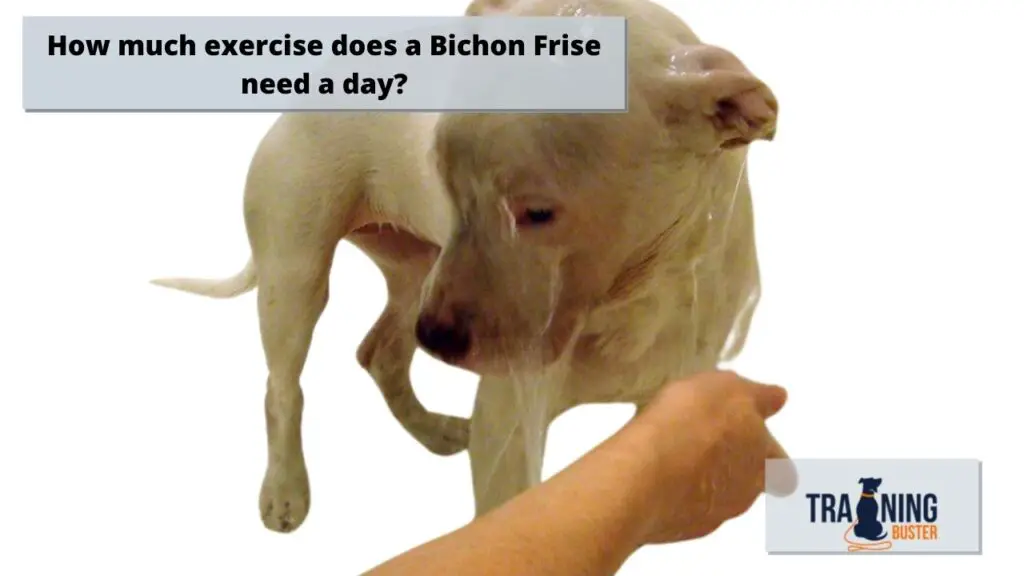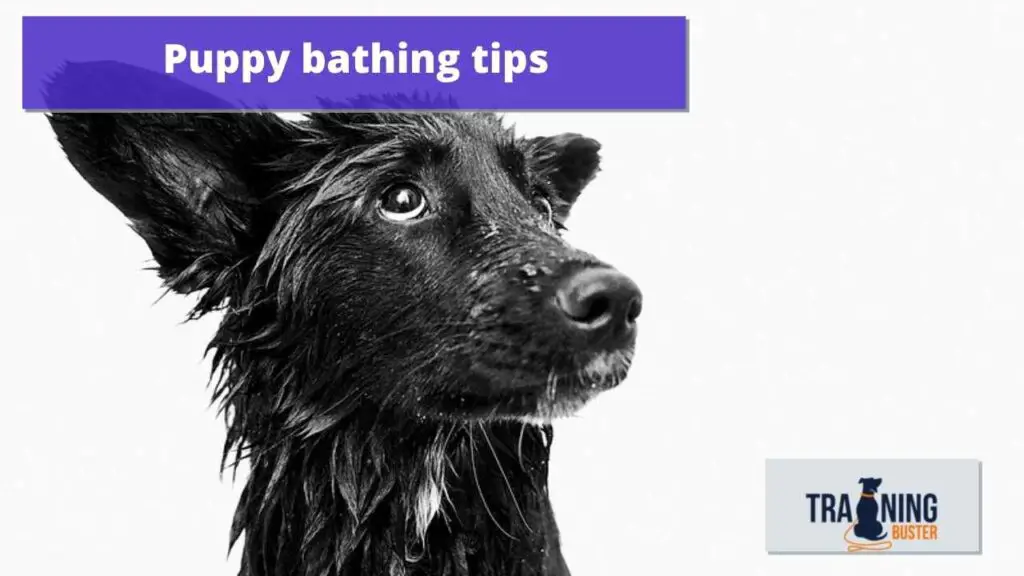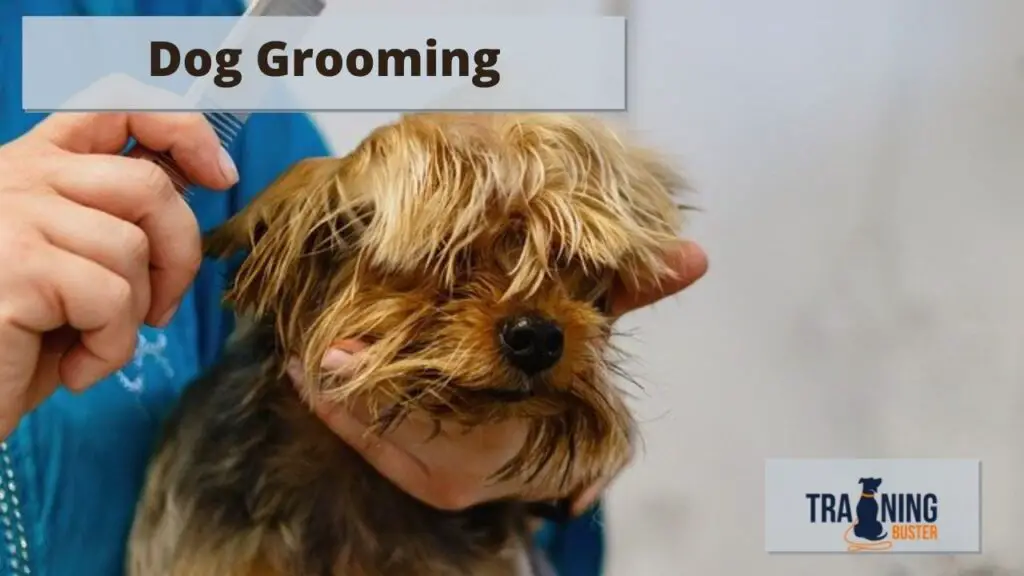
The quick answer is:
On average you should bathe a puppy once every two to three weeks. If your puppy gets dirty you can bathe more often. Make sure you use a gentle puppy shampoo.
Dogs by nature will need to be bathed from time to time in order to maintain basic hygiene and grooming standards. It is also imperative to bathe dogs to avoid health and skin issues such as fungal and bacterial problems.
At other times, it will be necessary to give them a bath when your dog is muddy, caked in dirt, or has rolled in something malodorous. Bathing your dog should not be complicated and is not dissimilar to the process you would use to bathe yourself.
This straightforward guide will discuss the process and share some helpful tips and pitfalls to avoid, especially for new dog owners.
How often should my puppy be bathed?
Factors such as dog odor, skin conditions, and levels of dirt or grime will determine how frequently your dog will need a bath. Working dogs who spend most of the year outdoors may require more frequent bathing than dogs who live predominantly indoors and don’t get as dirty.
If your dog’s odor doesn’t bother you, their fur isn’t visibly dirty or their lack of bathing doesn’t lead to health issues then there is no imminent need for dogs to take a bath. Although some dogs with allergic skin issues may need more frequent bathing because it will be part of their prescribed treatment. This means that some owners will choose to bathe their dogs monthly, whilst others only a few times per year.
Factors such as breed, size, fur thickness and length of fur, lifestyle factors, activity levels, and types of activity will dictate the amount of bathing your own dog will require.
It is something that your nose and common sense will help you determine. It is also essential that dogs aren’t bathed too frequently because it can cause skin irritations, especially if the skin isn’t dried well or harsh soaps are used.
Preparing to wash your puppy
Before starting, ensure your dog’s coat has been thoroughly brushed to get any knots or tangles out. If it is possible, it is wise to brush outdoors to avoid fur and lose hairs going through your home.
You can also lightly brush through whilst washing with a soft and wide bristled brush, but it is often better to do this before and after washing as once your dog is wet it’s best to get them dry again.
Choose an ideal washing space when bathing your pup
Consider the most ideal place to wash your dog knowing that it is likely to get wet when they shake the excess water off so choose the place where flying water splashes will not damage your home.
The shower recess of your home will be sufficient but some people choose to use a bathtub, laundry tub, a large wash bucket, or baby bath any other vessel that the dog can stand comfortably inside of in order to saturate the coat.
Prepare all that you will need including dog shampoo and towels for the ground and to rub dry afterward or ideally if you would like to be efficient, a premium dog drying robe as the BONAWEN which you can put on your dog to have it dried quickly and easily.
Lastly, it is advisable to wear a splash-proof apron so that your clothing is somewhat protected as dogs like to shake without warning once wet. Some people even choose to wear a rain poncho or jacket, but again, it is up to you!
Bathing your puppy
Let the water run and the temperature on the inside of your wrist (as you would test baby milk) to make sure it’s not too hot – as mentioned, dogs’ skin is sensitive so it should never be too hot.
Likewise, the bath will be a lot more enjoyable for your dog if the water isn’t too cold so it is best to aim for Lukewarm so that they enjoy the process and make it easier for you.
An uncomfortable, squirmy dog is never easy to wash. Then wet your dog down so that they are entirely saturated. Some people recommend against using high-pressure nozzles because the pressure can be frightening or unpleasant so you can break the pressure by using the backside of your hand, whilst simultaneously massaging through the fur to ensure that it is thoroughly wet.
Lather with a dog shampoo that’s appropriate for your dog, taking care to rub down the hind and buttocks. Avoid the eye area or getting it near the mouth making sure that they don’t ingest any of the shampoos. Wash the body of the dog first and lastly the head because this makes them shake.
Ensure there are sufficient suds to make sure the dirt is removed. Rinse well and ensure that all soap is removed. If in doubt, it is important to repeat rinsing because any soap residue can cause skin issues.
Some dog owners like to use a dog conditioner, however, this is entirely optional and will be sometimes helpful for longer coated breeds of dogs that are prone to getting knots.
It is a step entirely up to you and the process is the same but instead of getting suds, the product will be lathered or massaged through the coat and then again thoroughly rinsed.
12 Steps to bathe your puppy

STEP 1
Figure out if your puppy has had a bath recently. A reasonable interval between baths is one month, although it is unlikely you will dry the skin out if you use a mild dog shampoo and bathe it once every two weeks.
Dog skin is relatively unsophisticated and if you wash it too often, there is a risk of stripping out the beneficial oils that condition its skin and keep its coat soft.
STEP 2
Comb out your puppy’s coat. Before getting the puppy wet, comb out any tangles or knots. Depending on the coat type, use a wide-toothed comb (for coarse, wiry coats) or a fine-toothed comb (for soft silky coats) and thoroughly brush your puppy’s coat through. Pay particular attention to areas where fur rubs against itself, such as behind the ears and in the armpits or groin.
Gently tease out any knots. If they are too firmly knitted together, try to get the comb between the knot and the skin, and then carefully trim the knotted fur with scissors, cutting above the comb, away from the skin. If your puppy is wriggly, do not attempt to do this by yourself. If the puppy moves at the wrong moment you could cut its skin.
Instead, wait until a friend can hold your puppy steady, so you have both hands free to localize the knot and trim it off safely.
STEP 3
Put on clothes that you can get wet. Even a small puppy can make you surprisingly wet when he or she shakes. So you may wish to change into old clothes or wear a waterproof apron.
STEP 4
Decide where you are going to wash the puppy. To bath a large breed puppy indoors, the bathroom is the best place, because it is the most waterproof room. However, a small puppy will do just fine in the sink in the kitchen or bathroom. If the weather is very warm, you have the option to bathe your puppy outdoor in a tub or baby bath.
It needs to be very hot weather before you use unheated water (such as that supplied from a garden hose) on a young puppy, as puppies are prone to the cold.
STEP 5
Fill the tub without your puppy in it. Run the taps until the water is warm, around the temperature you would happily bathe a baby in. If in doubt, do the ‘elbow’ test, where you dip your elbow in the water to see if the temperature feels slightly warmer than your skin. Judge whether the water is too cold or too hot and adjust the temperature before you put your pup in.
STEP 6
Concentrate on reassuring your puppy, keeping your voice light and happy. Constantly tell him or her how clever they are. Just keep in mind that the first bath can be a scary time for your puppy, so remember to be as gentle as possible with all you do.
STEP 7
Gradually get your puppy wet. While continuing to pet your puppy with one hand, you should start to get its head and neck wet.
Use a plastic beaker and scoop water over your pup’s body, stroking it in between scoopfuls. Work in this way to completely wet the dog’s coat. Try to avoid getting water into your pup’s eyes. The dog should be completely wet before you put the shampoo on.
STEP 8
Suds your pup up. Slowly work about a dime’s worth of shampoo into your puppy’s fur. Make sure you get every inch covered, his or her paws need to be washed just as much as the neck.
Don’t forget to pay attention to every inch of the dog, including armpits, under the tail, and the groin. Your puppy should look like a cuter, smaller version of the abominable snowman by the time you’re done.
STEP 9
Wash your puppy’s face separately. You should use a washcloth dipped into lukewarm water to wash your puppy’s face. Gently rub the face with the washcloth, avoiding the eyes as much as possible. It may be difficult to get your pup’s face washed. Be patient and wait until your puppy is relatively calm before attempting to get their cute little face clean.
STEP 10
Rinse thoroughly, washing out the shampoo suds. Drain the soapy water and begin rinsing with clean water. Rinsing is one of the most important parts of the bathing experience. You will have to rinse your puppy more than once. Pour water over your pup until no suds are left in the fur. You want to make sure to get all of the soap because any shampoo that is leftover could cause skin irritation.
Never leave the dog in the sink or bath while the taps are running. To do so is frightening for the puppy and there is a risk of scalding if the puppy gets underneath the hot tap.
Instead, lift the puppy out of the sink or tub while you are refilling it, wrapping the pup up in a towel to keep it warm. Your towel will get covered in soap, and you will need another to actually dry the dog, but your pup will stay warm. If your pup is very wrinkly or has a long coat, be extra attentive when it comes to rinsing out all of the shampoo.
STEP 11
Dry your pup. Remove the puppy from the tub and wrap it in a clean, dry towel. Rough dry using the towel. You can also use a blow dryer set on a low, cool setting after you have used a towel. Hold the dryer at least 12 inches (30.5 cm) from the puppy. Keep the dryer moving so that if by any chance it is too hot, it is not focused on one spot and causes a burn.
If you are bathing your puppy outside on a hot day, you can let your pup shake and run around to get dry.#
STEP 12
Give your pup some love. After the whole bathing experience, it is really important that you tell your puppy how good a dog it is. You may also want to reward it with a favorite puppy treat to reinforce good behavior.
Grooming your puppy after a bath

Grooming your pup is more than just making them look pretty. Grooming sessions remove dead hair, keep the coat and skin healthy, and give you a chance to check their general health– all while spending quality time together that builds trust between owner-and-pet!
Scientific evidence has shown these grooming sessions decrease stress levels for both of you by providing relaxation through gentle touching; additionally, they reduce blood pressure in humans which makes it easier on our ticker’s heart rate.
Grooming isn’t just about getting rid of your dog’s pesky body hair or helping him smell better — regular care provides an opportunity to build relationships with your pet.
Different types of puppy coats
Once your puppy is settled, your grooming routine will depend on your puppy’s coat type.
Smooth dog Coats
Is your dog’s coat a smooth one? If so, you won’t have to groom as often. A quick once-over each week is enough (although it can be nice for both of you if they get brushed more).
You’ll need rubber brushes or grooming mitts in order to remove any dirt and dead hair that may accumulate on the body. These tools will also loosen up tangles which could occur during brushing with fur-type bristles only.
Short Coats
With short-haired breeds, it’s important to brush your pet regularly. The first step is using a pinhead brush that will remove knots and tangles from the fur. Then use a bristle brush which will give them their refreshing coat of hair by removing dirt and dead hairs altogether!
Long Coats
These require daily attention to avoid knots. Begin using a pinhead brush or comb to untangle matted hair. Never cut out mats using scissors. Comb the hair with a wide-toothed comb, taking particular care around the backside, tail and legs. Trim any hairs that have got out of control.
Silky Coats
These need a lot of attention. Start by teasing out tangles with a pinhead brush or comb, then use a bristle brush to bring out the natural shine. To give your dog a bit of style, opt for a center parting, brushing downwards on either side. Trim wayward hairs.
Styling your puppys fur after bathing

Some breeds require special grooming techniques. Your breeder or a professional groomer can advise you of your breed’s specific needs, but as a rough guide:
- Terriers need stripping (where dead hair is plucked from the coat);
- Some breeds, such as poodles, need scissoring into shape;
- Some long-coated show dogs, such as the Yorkshire terrier, need the coat put into wrappers (papers) to protect it.
- Extensive matting or snarls can accelerate damage to surrounding hairs. If your dog has a challenging coat, enjoys a daily dip in the pond, or if you’d rather be walking your dog than combing him, consider regular visits to a professional groomer who can provide a soothing bath, gentle hair drying and a thorough brushing.
The Importance of Drying your dog
It is essential to get dogs thoroughly dry as quickly as possible, this is especially true for double or thick-coated and long-haired breeds such as Old English Sheepdogs. There are a number of reasons why, apart from comfort to the dog, but the primary reasons are that damp, warm fur becomes a perfect breeding ground for fungal infections.
Wet and damp patches of skin tend to easily become areas called hot spots, which is otherwise known as acute moist dermatitis or what might look like red, irritated, and moist lesions. Dogs will often start licking at these, which will quickly worsen the issue.
If your dog is showing any signs of irritation after a bath, it is important to call and speak to a vet. Especially in the case of red spots, wounds, or bumps on the skin that could turn into hot spots or other allergies.
Any anomalies should be treated as soon as possible to ensure that the issue does not become agitated or wounds don’t become enlarged.
Also, note that various shampoos or other elements can cause allergic reactions on dogs’ skin.
If you see anything out of the ordinary it is always crucial that you seek the advice of a professional veterinarian. Also if your dog has ingested any shampoo or conditioner then it is also important to seek immediate advice.
Do I really need to bathe my puppy?
You are right to question if bathing is necessary because too much bathing will strip the puppy’s coat of its’ natural oils. However, sometimes puppies roll in unpleasant things or just plain get muddy.
If the dog’s coat is soiled, then this can harbor bacteria which could then set up a skin infection, so occasional bathing helps to reduce bad smells, clean the coat, and keep the skin healthy.
Can I make my dog enjoy baths?
Usually, it depends on breed, but if your dog doesn’t like baths, it may be very hard to get him/her used to them. You can make baths more enjoyable for your dog by offering treats before and after, and giving them toys to play within the bath.


